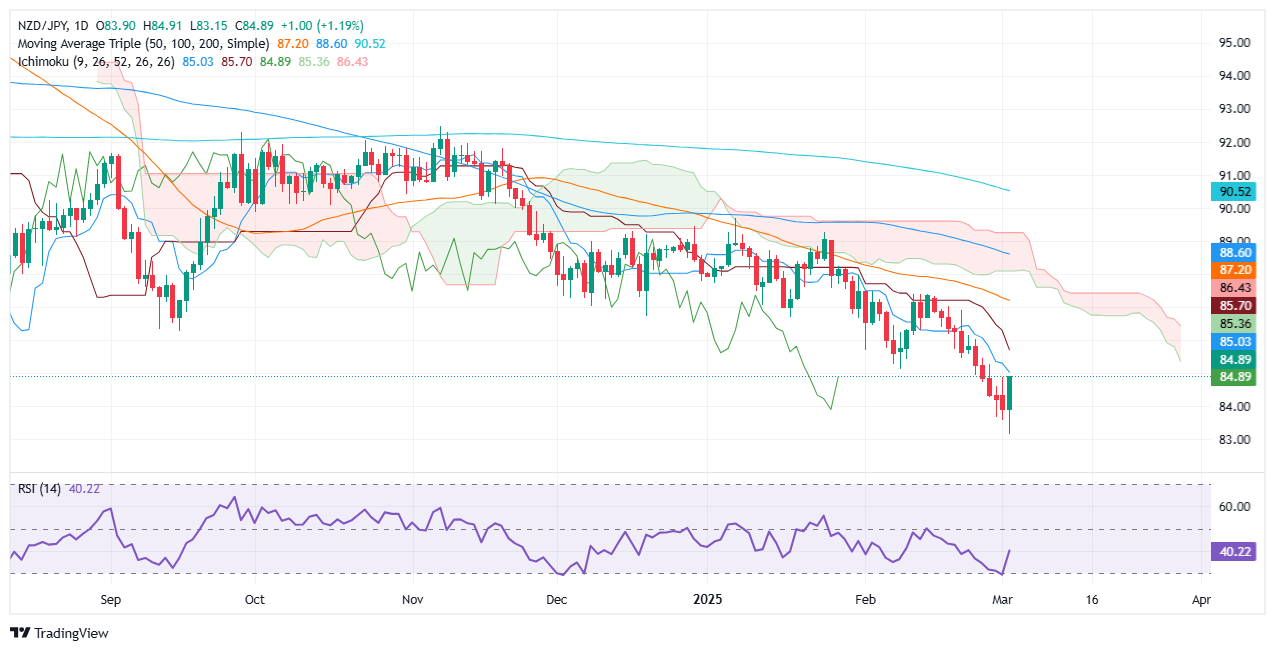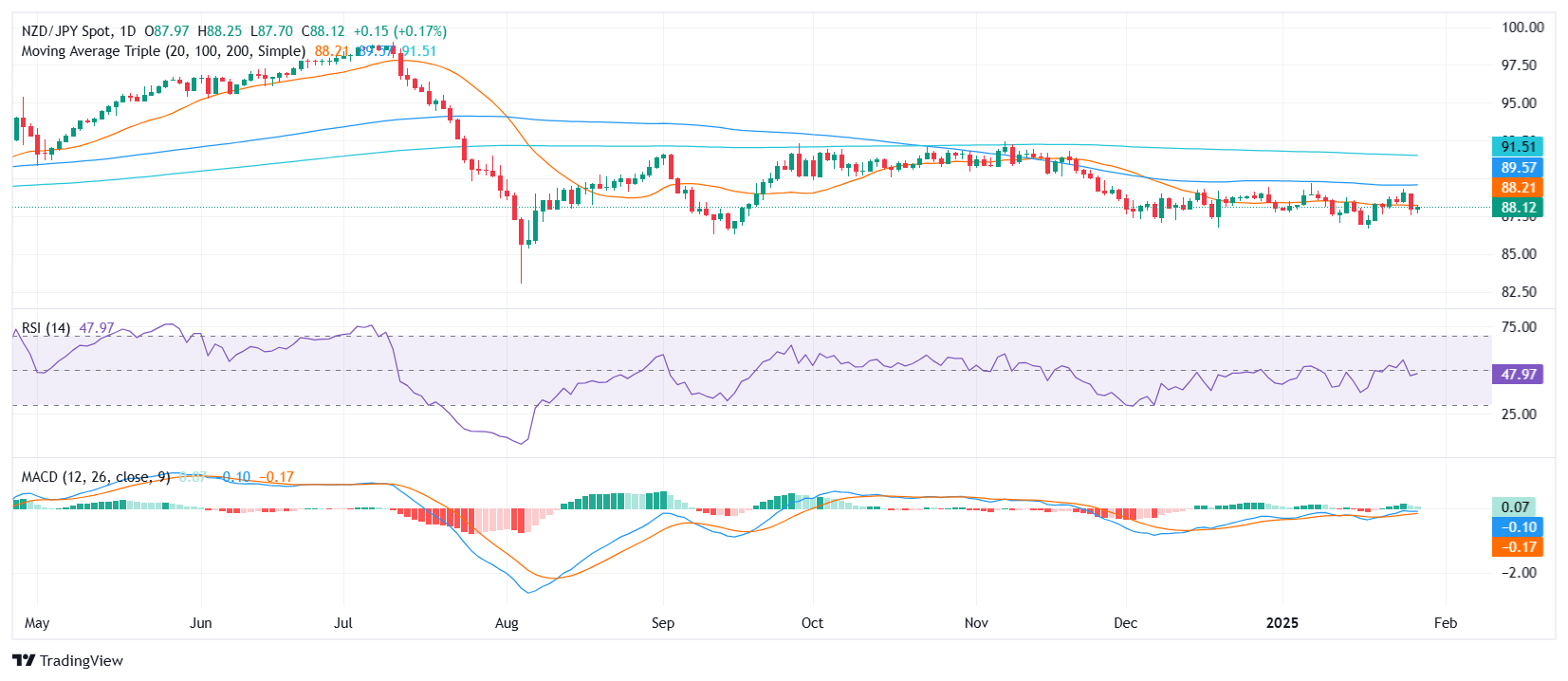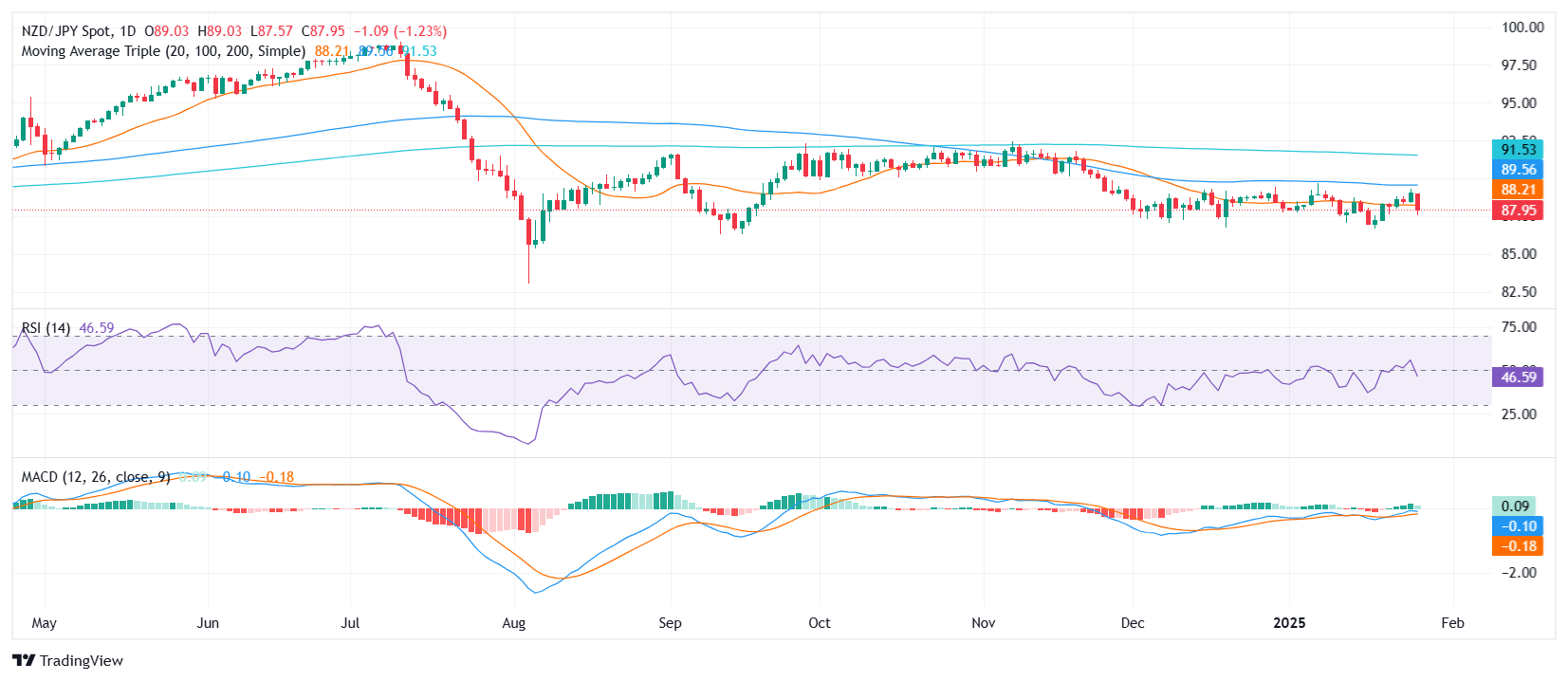- Analytics
- News and Tools
- Quotes
- Chart and quotes for NZDJPY
CFD Trading Rate New Zealand Dollar vs Japanese Yen (NZDJPY)
| Date | Rate | Change | |
|---|---|---|---|
| 31.03.2025 | 85.24 | 0.15% | |
| 30.03.2025 | 85.114 | -0.61% | |
| 27.03.2025 | 85.636 | -1.20% | |
| 26.03.2025 | 86.676 | 0.59% | |
| 25.03.2025 | 86.167 | 0.28% | |
| 24.03.2025 | 85.929 | -0.40% | |
| 23.03.2025 | 86.277 | 0.79% | |
| 20.03.2025 | 85.597 | -0.03% | |
| 19.03.2025 | 85.621 | -1.15% | |
| 18.03.2025 | 86.616 | -0.23% |
Related news
-
04.03.2025 23:06NZD/JPY Price Forecast: Bounces off 7-month low, but downtrend remains
- NZD/JPY must break above 85.03 (Tenkan-Sen) to extend recovery.
- Key resistance levels lie at 85.40 (Senkou Span A) and 85.66 (Kijun-Sen).
- Failure to hold above 84.00 could reopen the path toward YTD low of 83.15.
The NZD/JPY recovered some ground on Tuesday after dropping to a seven-month low of 83.15. The pair finished the session near 84.90 for gains of over 1%. At the time of writing, the cross-pair trades near 85.00, virtually unchanged as the Wednesday Asian session begins.
NZD/JPY Price Forecast: Technical outlook
Despite posting a bullish candle, the NZD/JPY remains biased downward, with the exchange rate hovering near the Tenkan-Sen at 85.03. A breach of the latter will expose the Senkou Span A at 85.4, immediately followed by the Kijun-Sen at 85.66. The next stop would be Senkou Span B at 86.43 on further strength.
Conversely, if NZD/JPY drops below 84.00, the next support would be the year-to-date (YTD) low of 83.15, followed by the August 5 low of 83.05, before diving to 83.00. A breach of the latter will send the cross sliding to a two-year low near April 27, 2023, a low of 81.63.
NZD/JPY Price Chart – Daily

New Zealand Dollar FAQs
The New Zealand Dollar (NZD), also known as the Kiwi, is a well-known traded currency among investors. Its value is broadly determined by the health of the New Zealand economy and the country’s central bank policy. Still, there are some unique particularities that also can make NZD move. The performance of the Chinese economy tends to move the Kiwi because China is New Zealand’s biggest trading partner. Bad news for the Chinese economy likely means less New Zealand exports to the country, hitting the economy and thus its currency. Another factor moving NZD is dairy prices as the dairy industry is New Zealand’s main export. High dairy prices boost export income, contributing positively to the economy and thus to the NZD.
The Reserve Bank of New Zealand (RBNZ) aims to achieve and maintain an inflation rate between 1% and 3% over the medium term, with a focus to keep it near the 2% mid-point. To this end, the bank sets an appropriate level of interest rates. When inflation is too high, the RBNZ will increase interest rates to cool the economy, but the move will also make bond yields higher, increasing investors’ appeal to invest in the country and thus boosting NZD. On the contrary, lower interest rates tend to weaken NZD. The so-called rate differential, or how rates in New Zealand are or are expected to be compared to the ones set by the US Federal Reserve, can also play a key role in moving the NZD/USD pair.
Macroeconomic data releases in New Zealand are key to assess the state of the economy and can impact the New Zealand Dollar’s (NZD) valuation. A strong economy, based on high economic growth, low unemployment and high confidence is good for NZD. High economic growth attracts foreign investment and may encourage the Reserve Bank of New Zealand to increase interest rates, if this economic strength comes together with elevated inflation. Conversely, if economic data is weak, NZD is likely to depreciate.
The New Zealand Dollar (NZD) tends to strengthen during risk-on periods, or when investors perceive that broader market risks are low and are optimistic about growth. This tends to lead to a more favorable outlook for commodities and so-called ‘commodity currencies’ such as the Kiwi. Conversely, NZD tends to weaken at times of market turbulence or economic uncertainty as investors tend to sell higher-risk assets and flee to the more-stable safe havens.
-
19.02.2025 04:50NZD/JPY struggles to capitalize on bounce from post-RBNZ low, remains below 87.00
-
13.02.2025 21:41NZD/JPY Price Analysis: Bears tighten grip as rejection at 20-day SMA fuels downside pressure
-
10.02.2025 21:53NZD/JPY Price Analysis: Pair stabilizes but remains below key resistance
-
03.02.2025 22:01NZD/JPY Price Analysis: Pair plunges to multi-month low before partial rebound
-
28.01.2025 21:51NZD/JPY Price Analysis: Pair rebounds but struggles to gain traction
-
27.01.2025 22:42NZD/JPY Price Analysis: Sharp decline extends bearish outlook
-
23.01.2025 21:40NZD/JPY Price Analysis: Pair edges lower amid fading bullish momentum
-
16.01.2025 21:58NZD/JPY Price Analysis: Fresh sell-off signals deeper downside potential
-
15.01.2025 21:55NZD/JPY Price Analysis: Fresh decline heightens downside risk
-
13.01.2025 21:45NZD/JPY Price Analysis: Pair struggles within 89.00–87.00 channel
-
08.01.2025 21:40NZD/JPY Price Analysis: Pair stumbles below 100-day SMA, leaving rally in doubt
-
07.01.2025 22:00NZD/JPY Price Analysis: Pair tests 100-day SMA amid steady momentum
© 2000-2025. All rights reserved.
This site is managed by Teletrade D.J. LLC 2351 LLC 2022 (Euro House, Richmond Hill Road, Kingstown, VC0100, St. Vincent and the Grenadines).
The information on this website is for informational purposes only and does not constitute any investment advice.
The company does not serve or provide services to customers who are residents of the US, Canada, Iran, The Democratic People's Republic of Korea, Yemen and FATF blacklisted countries.
Making transactions on financial markets with marginal financial instruments opens up wide possibilities and allows investors who are willing to take risks to earn high profits, carrying a potentially high risk of losses at the same time. Therefore you should responsibly approach the issue of choosing the appropriate investment strategy, taking the available resources into account, before starting trading.
Use of the information: full or partial use of materials from this website must always be referenced to TeleTrade as the source of information. Use of the materials on the Internet must be accompanied by a hyperlink to teletrade.org. Automatic import of materials and information from this website is prohibited.
Please contact our PR department if you have any questions or need assistance at pr@teletrade.global.


























